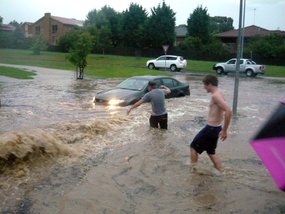
Thunderstorms and torrential rain hit metropolitan Melbourne last night with around 5000 calls for help due to the widespread flash flooding. The wild weather condition blacked out homes and cut off major roads. Residents in low-lying areas were advised to evacuate immediately to safe areas as the situation is expected to worsen.
Also affected are areas in the western, central and northern part of Victoria. Waterways overflowed while streets and highways were flooded causing chaos to commuters and businesses. There were also cars and homes inundated by the flood water.
Rainfall in Lyndhurst and Mildura had their highest rainfall recorded ever. For the towns of Creswick and Clunes, it is their fourth flood within five months. Authorities also issued warning of damaging winds, more floods and hailstorms. Other affected regions were Dandenong, Mildura, Geelong and Bendigo.
The Victorians experienced a series of super-cell storms with gusty winds and rainwater that knocked trees, damaged properties and crops and also flooded roads and homes across the state.
What is a super-cell storm? It is a type of thunderstorm with large-scale rotation. It is not common but can be severe and destructive. It can happen anywhere in the world but usually occur in the Great Plains of the United States.
Recorded super-cell storms in Australia: 1999 – East coast of New South Wales; 2007 – Canberra; 2010 – Melbourne and Perth; 2011 Victoria






